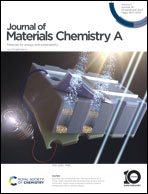Lithium-ion storage mechanism in closed pore-rich hard carbon with ultrahigh extra plateau capacity†
Abstract
Hard carbon (HC) materials have demonstrated great potential in sodium-ion storage; however, their application for lithium-ion storage continues to pose a challenge due to difficulties in managing carbon porosity. Most HCs exhibit completely capacitive responses when storing lithium ions, significantly hindering the nominal cell voltage of configured lithium-ion batteries. Herein, this study provides feasible solutions by introducing phenolic-formaldehyde resin-derived HCs with tunable microporous structures. The carbon porosity is well manipulated by tailoring chemically cross-linked environments via microwave-induced polymerization. A highly closed microporous HC (closed pore volume: 0.336 cm3 g−1), verified by multiple gas (N2, O2, and CO2) adsorptions, is successfully prepared by reducing the cross-linking degree. Combining in situ X-ray diffraction and ion-diffusion kinetic explorations, the linchpin has been clearly identified. Closed ultramicropores of <0.7 nm, which play the same role as the graphitic interlayer spacing in graphite, are termed as “active closed pores”, because they can facilitate the insertion of lithium ions and mitigate substantial initial irreversible capacity by blocking the penetration of solvents. The HC with abundant active closed pores can deliver a reversible capacity of 550 mAh g−1 at 50 mA g−1 in 0.001–1.5 V, with an ultrahigh low-voltage plateau capacity of 230 mAh g−1 contributed by the lithium-ion insertion in active closed pores. The excellent rate capability (210 mAh g−1 at 2 A g−1) and cycling stability (90% capacity retention after 200 cycles at 0.1 A g−1) of this closed pore-rich HC are also confirmed, which is thus recognized as an ideal material for negative electrodes in lithium-ion batteries. This breakthrough discovery has enlightened the full potential of hard carbon materials for next-generation batteries.



 Please wait while we load your content...
Please wait while we load your content...